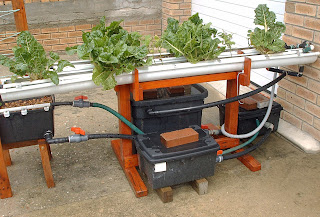Its tough being a farmer in South Africa. While some farmers do seem to be well rewarded for their input, others, with no less input, are dealt a life and "reward" which makes you question their insistence/sanity in pursuing their profession.
From the large land area of South Africa, only 12% is arable land for crop production. It is pretty amazing that farmers are able to produce enough food in a good year to feed all of us.
I read that the average annual rainfall for most areas of the Cape is about 500 mm, while yet in certain areas, it is less than 200 mm. Would you rather be a farmer in the beautiful Cape Winelands, usually with enough rainfall, fairly close to big towns or cities, or be a farmer in some dry, desolate area of the Karoo, perhaps up to 90 km or more from the nearest town or 20 - 50 km to the nearest neighbour along gravel roads, which you have to maintain yourself in many instances, praying daily for annual rain?
What does apply to all South African farmers is that they do not receive subsidies of any description and so, there is huge risk attached to farming, through volatile market prices and periodic natural and man-made disasters.
A recent example of a farmer's lot is the story of a young farmer in a punishing climate and environment. After eight years without good rain, recently, the heavens opened to give forth wonderful rain over a period of days. Pretty soon, the huge dam that had been built by his family 50 years ago, was full. In the middle of the night, he awoke to hear the nearby river roaring past the farmhouse, despite the rain having ceased a few days previously. In daylight, the sight of a huge hole in the earthen dam wall revealed that, unseen, a type of ant colony, without the pressure and threat of water, had made their home within the wall for the last eight years, turning compacted earth to the consistency of beach sand. Ants had created this certain disaster for the future and not even 50cm of the water remained in the dam. The farmer gave thanks that the wall had eroded over a period of hours rather than had it burst in one moment and swept away home and family. But it is still a hardship to bear. The wall will take millions of rands to replace, if ever.
Another example is the recent epidemic which spread through the ostrich-farming industry. Farmers were forced to destroy any livestock which had not yet succumbed to the disease and, despite being promised by the Government some compensation for this culling, many farmers have either had to start again from scratch when the small compensation has not nearly fulfilled its purpose or, applied for bankruptcy where compensation has not materialized.
Another blot on the agricultural horizon is the hot topic of fracking for gas in the middle of Karoo farmland areas.
This is shooting a new fear through the hearts of the farmers.
The threat of land distribution also hangs like a sword of Damocles over farmers. There was a "Willing buyer (government), willing seller " scheme initiated a few years ago and yet, when a willing seller was found and papers were drawn up for the sale, the buyer ultimately caused a sale to hang in limbo for so long that market prices altered greatly in the interim, creating issues for one or other of the parties, who then needed to renegotiate from scratch in order to achieve their planned "next property purchase", and all the while, the current owner/farmer and the wanna-be farmer were prevented from moving on with the next step of their lives. Frustrated complaints and fallout created opportunity and platforms for much political posturing, denial of sabotage and implied lack of co-operation on the part of the seller, which led to some "new" ideas for land distribution.
In a worrying development, we, as city slickers, hear about the government possibly forcing the sale of huge portions of each farm, or entire farms where ancestral ownership is proved, for
less than market value. Would such a forced sale also include implements, irrigation pipes and other infrastructure below value? Some would-be politicians even expound expropriation without compensation! Just thinking about it all, it makes me feel depressed and because its not in my backyard, for sanity sake, its easier to discount it all as a blip in the grand scheme of things while I continue to enjoy the view of the inside of my hole in the sand, whether as an ostrich or an ant. However, apart from the financial and political impact, what should be of concern to me as a consumer is that, if inexperienced farmers are handed the land to try and make a go of it, even if half of them succeed, the failure of the other half could gradually erode our food security. One only has to look North to see that it is not an overly pessimistic concern. For our sakes, one must hope that these new farmers who are given this land, are also provided with some form of free agricultural training, equipment and advice which will compensate for the lack of generations of knowledge.
Crime affects all of us and no less, the farming community. Theft of fruit and veg on a grand scale in order to sell openly and freely to commuters alongside our National roads, digs deep gouges into farmers' profits and fences. Grapes along the N1 in De Doorns, apples along the N2 atop Sir Lowry's Pass are just some examples of what can be purchased by the buyer who is willing to perpetuate this practice. Stock-theft, which is probably common worldwide, carries heavier penalties, if the crime is ever followed up and successfully punished. I would guess this is because, historically and traditionally, livestock visibly indicates a farmers' worth and this perception is prevalent across all groups of people.
Murder of farmers and their families takes place regularly and without
too much comment or outrage beyond their immediate communities. Even if a
particularly gruesome murder is splashed across the headlines, the
shock and disgust is soon forgotten amidst all the other negative
happenings in our crazy world. Although labelled as criminal, many
believe the crimes to be politically motivated, based on past injury
dealt out by our parents and grandparents or based on the fueling of
fear and hate, promises and perceptions as hammered out and chanted in
"historical songs" by current politicians and media at election time or
whenever a politician is threatened with exposure and needs to distract
everyone from his hand in the taxpayers' cookie jar. Would you be happy
to own and work a farm where the previous farmer and his family were
cruelly and deliberately deprived of life for being a farmer?
Thank heavens there are old families who have handed down the love and tradition of farming so that their children and grandchildren desire no easier form of life and living and where the actual work holds no fear or doubts, thanks to generations of knowledge.
And yet, as pressure becomes too great from all sides, some ask themselves whether their love of this country necessarily has to be entwined with the love of farming. They begin to follow the example of other professionals, who are forced to work far from home in alien cultures and climates because the masses of the unemployed, understandably, necessitates affirmative action in employment practices at home. We read of farmers moving to countries in the North where their skills are so valued that land, profits and help are not begrudged them in return for that country's food security and wealth.
Who would a farmer be?




































